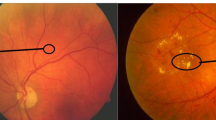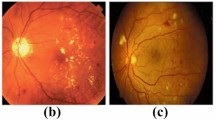Abstract
Microaneurysms, tiny, circular red dots that occur in retinal fundus images, are one of the earliest symptoms of diabetic retinopathy. Because microaneurysms are small and delicate, detecting them can be difficult. Their small size and cunning character make automatic detection of them difficult. The automatic detection of microaneurysms in retinal fundus images is proposed in this research using a local Fourier transform and neighbourhood analysis-based multi-scale approach technique. The suggested method is broken down into three stages: image preprocessing, the detection of retinal vessels and microaneurysm candidates, and labelling of the candidates. A multi-scale framework is used to develop every stage of the algorithm, with the exception of the initial image preprocessing, giving the mechanism for efficient microaneurysms detection. In contrast to the short-time Fourier transform, which extracts the neighbourhood of each pixel and calculates each local Fourier transform separately, the local Fourier transform is employed in this study to extract the MA. After that, neighbourhood analysis is performed to name the microaneurysm because the item is actually a collection of independent little images rather than the entire image. Three separate data sets and different types of performance indicators are used to examine the robustness of the proposed model. Through the prominent performance, the proposed model is able to outperform other existing models. The classification accuracy of the proposed method for MESSIDOR and ORIGA data set is 99.28% and 98.95%, respectively.







Similar content being viewed by others
Data availability
In this article, the different normal and abnormal images are collected from publicly available dataset. Data sharing not applicable to this article as no datasets were generated or analysed during the current study.
References
Ram K, Joshi G, Sivaswamy J (2011) A successive clutter-rejection-based ap- proach for early detection of diabetic retinopathy. IEEE Trans Biomed Eng 58(3):664–673
Pereira C et al (2014) Using a multi-agent system approach for microaneurysm detection in fundus images. Artif Intell Med 60(3):179–188
Lazar I, Hajdu A (2013) Retinal microaneurysm detection through local rotating cross-section profile analysis. IEEE Trans Med 32(2):400–407
Nunes S, Pires I, Rosa A, Duarte L, Bernardes R, Cunha-Vaz J (2009) microaneurysm turnover is a biomarker for diabetic retinopathy progression to clinically significant macular edema: findings for type 2 diabetics with nonproliferative retinopathy. Ophthalmologica 223(5):292–297
Seoud L, Hurtut T, Chelbi J, Cheriet F, Langlois JM (2016) Red Lesion detection using dynamic shape features for diabetic retinopathy screening. IEEE Trans Med Imaging. https://doi.org/10.1109/TMI.2015.2509785
Mahiba C, Jayachandran A (2019) Severity analysis of diabetic retinopathy in retinal images using hybrid structure descriptor and modified CNNs. Measurement 135:762–767
Jayachandran A, Shunmugarathinam G, Perumal TSR (2023) Retinal vessels segmentation of colour fundus images using two stages cascades convolutional neural networks. J Ambient Intell Hum Comput Secur 14(7):9305–9315
Namboodiri S, Jayachandran A (2020) Multi-class skin lesions classification system using probability map based region growing and DCNN. Int J Comput Intell Syst 13(1):77–84
N. Eftekhari, H. R. Pourreza, M. Masoudi, K. Ghiasi-Shirazi, E. Saeedi, Microaneurysm detection in fundus images using a two-step convolu- tional neural network, BioMed Eng Online (2019). arXiv:1710.05191. https://doi.org/10.1186/s12938-019-0675-9.
Adal KM et al (2014) Automated detection of microaneurysms using scale- adapted blob analysis and semi-supervised learning. Comput Methods Programs Biomed. https://doi.org/10.1016/j.cmpb.2013.12.009
Javidi M, Pourreza HR, Harati A (2017) Vessel segmentation and microaneurysm detection using discriminative dictionary learning and sparse representation. Comput Methods Programs Biomed. https://doi.org/10.1016/j.cmpb.2016.10.015
Rodrigues J, Bezerra N (2017) Retinal vessel segmentation using parallel grayscale skeletonization algorithm and mathematical morphology. In: Proceedings—2016 29th SIBGRAPI Conf. Graph. Patterns Images, SIBGRAPI 2016, pp 17–24
Jesu Prabhu A, Jayachandran A (2018) Mixture model segmentation system for parasagittal meningioma brain tumor classification based on hybrid feature vector. J Med Syst 42:12
Giancardo L, Meriaudeau F, Karnowski T, Tobin K, Li Y, Chaum E (2010) Microaneurysms detection with the radon cliff operator in retinal fundus images. SPIE Med Imaging 7623:29
Palanivel DA, Natarajan S, Gopalakrishnan S (2020) Retinal vessel segmentation using multifractal characterization. Appl Soft Comput J 94:106439
Chudzik P, Majumdar S, Calivá F, Al-Diri B, Hunter A (2018) Microaneurysm detection using fully convolutional neural networks. Comput Methods Programs Biomed 158:185–192
Zhang B, Wu X, You J, Li Q, Karray F (2010) Detection of microaneurysms using multi-scale correlation coefficients. Pattern Recogn 43(6):2237–2248
Niemeijer M, Staal J, Abramoff M, Suttorp-Schulten M, van Ginneken B (2005) Automatic detection of red lesions in digital color fundus pho- tographs. IEEE Trans Med Imaging 24:584–592
Dai B, Wu X, Bu W (2016) Retinal microaneurysms detection using gradient vector analysis and class imbalance classification. PLoS ONE. https://doi.org/10.1371/journal.pone.0161556
Samuel PM, Veeramalai T (2021) VSSC Net: vessel specific skip chain convolutional network for blood vessel segmentation. Comput Meth Programs Biomed 198:105769
Soomro TA, Afifi AJ, Gao J, Hellwich O, Zheng L, Paul M (2019) “Strided fully convolutional neural network for boosting the sensitivity of retinal blood vessels segmentation. Expert Syst Appl 134:36–52
Li X, Jiang Y, Li M, Yin S (2021) Lightweight Attention Convolutional Neural Network for Retinal Vessel Image Segmentation. IEEE Trans Ind Inform 17:1958–1967
Ramos-Soto O, Rodríguez-Esparza E, Balderas-Mata SE, Oliva D, Hassanien AE, Meleppat RK, Zawadzki RJ (2021) An efficient retinal blood vessel segmentation in eye fundus images by using optimized top-hat and homomorphic filtering. Comput Methods Programs Biomed 201:105949
Saha Tchinda B, Tchiotsop D, Noubom M, Louis-Dorr V, Wolf D (2021) Retinal blood vessels segmentation using classical edge detection filters and the neural network. Inform Med Unlocked 23:100521
Jebaseeli TJ, Deva Durai CA, Peter JD (2019) Retinal blood vessel segmentation from diabetic retinopathy images using tandem PCNN model and deep learning based SVM. Optik (Stuttg). 199:163328
Palanivel DA, Natarajan S, Gopalakrishnan S (2020) Retinal vessel segmentation using multifractal characterization. Appl Soft Comput 94:106439
Yan Z, Yang X, Cheng K-T (2018) Joint segment-level and pixel-wise losses for deep learning based retinal vessel segmentation. IEEE Trans Biomed Eng 65:1912–1923
Yan Z, Yang X, Cheng K-T (2019) A three-stage deep learning model for accurate retinal vessel segmentation. IEEE J Biomed Health Inform 23:1427–1436
Jayachandran A, David DS (2018) Textures and intensity histogram based retinal image classification system using hybrid colour structure descriptor. Biomed Pharmacol J 11(1):577–582
Ghaderi R, Hassanpour H, Shahiri M (2007) Retinal vessel segmentation using the 2-D Morlet wavelet and neural network. In: 2007 international conference on intelligent and advanced systems. IEEE
Hatanaka Y, Inoue T, Okumura S, Muramatsu C, Fujita H (2012) Automated microaneurysm detection method based on double-ring filter and feature analysis in retinal fundus images. In: Computer-based medical systems (CBMS), pp 1–4
Mizutani A et al (2009) Automated microaneurysm detection method based on double-ring filter in retinal fundus images. In: Karsse- meijer N, Giger ML (Eds) SPIE medical imaging 2009: 105–112, 2002. Computer-Aided Diagnosis, vol 7260
Soares I, Castelo-Branco M, Pinheiro A (2014) Microaneurysms detection using a novel neighborhood analysis. In: Proceedings of the Ophthalmic Med. Image Anal. First International Workshop, OMIA 2014, Held in Conjunction with MICCAI 2014, pp 65–72
Milletari F et al. (2016) V-net: fully convolutional neural networks for volumetric medical image segmentation. In: 2016 fourth international conference on 3D vision (3DV). IEEE
Staal J, Abramoff MD, Niemeijer M, Viergever MA, Ginneken BV (2004) Ridge-based vessel segmentation in color images of the retina. IEEE Trans Med Imaging 23:501–509
Wang L, Gu J, Chen Y, Liang Y, Chen H (2021) Automated segmentation of the optic disc from fundus images using an asymmetric deep learning network. Lect Notes Comput Sci 112(6):107810
Ronneberger O, Fischer P, Brox T (2015) U-Net: convolutional networks for biomedical image segmentation. In: Proc. Med. Image Comput. Comput. Assist. Intervention, pp 234–241
Escorcia-Gutierrez J, Torrents-Barrena J, Gamarra M, Romero-Aroca P, Valls A, Puig D (2021) A color fusion model based on markowitz portfolio optimization for optic disc segmentation inretinal images. Expert Syst Appl 174:114697
Thakur N, Juneja M (2019) Optic disc and optic cup segmentation from retinal images using hybrid approach. Expert Syst Appl 127(Aug.):308–322
Nie D, Trullo R, Lian J, Wang L, Petitjean C, Ruan S, Wang Q, Shen D (2018) Medical image synthesis with deep convolutional adversarial networks. IEEE Trans Biomed Eng 65(12):2720–2730
Tulsani A, Kumar P, Pathan S (2021) Automated segmentation of optic disc and optic cup for glaucoma assessment using improved UNET++ architecture. Biocybern Biomed Eng 41(18):819–832
Acknowledgements
This work was not supported from funding Agencies.
Author information
Authors and Affiliations
Corresponding author
Ethics declarations
Conflict of interest
The authors declare that they have no conflict of interest.
Additional information
Publisher's Note
Springer Nature remains neutral with regard to jurisdictional claims in published maps and institutional affiliations.
Rights and permissions
Springer Nature or its licensor (e.g. a society or other partner) holds exclusive rights to this article under a publishing agreement with the author(s) or other rightsholder(s); author self-archiving of the accepted manuscript version of this article is solely governed by the terms of such publishing agreement and applicable law.
About this article
Cite this article
Perumal, T.S.R., Jayachandran, A. & Kumar, S.R. Microaneurysms detection in fundus images using local Fourier transform and neighbourhood analysis. Knowl Inf Syst 66, 1403–1423 (2024). https://doi.org/10.1007/s10115-023-01991-7
Received:
Revised:
Accepted:
Published:
Issue Date:
DOI: https://doi.org/10.1007/s10115-023-01991-7




